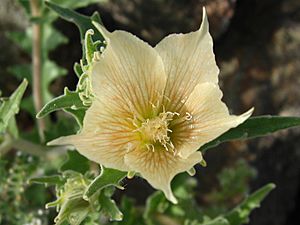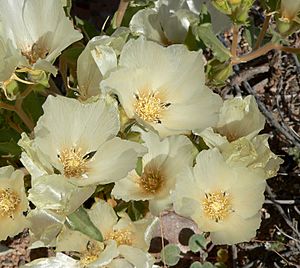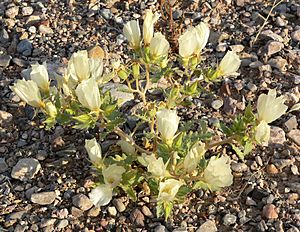Mentzelia involucrata facts for kids
Quick facts for kids Mentzelia involucrata |
|
|---|---|
 |
|
| Scientific classification | |
| Genus: |
Mentzelia
|
| Species: |
involucrata
|
Mentzelia involucrata is a cool plant often called the sand blazing star or white-bract blazing star. It's a type of Mentzelia plant that grows naturally in the hot, dry Mojave and Sonoran deserts of North America. You can find it in places like Nevada, Arizona, and Baja California in Mexico. Its traditional name from some Native American tribes is kuʼu.
Contents
About the Sand Blazing Star
The sand blazing star is an annual plant, which means it lives for only one growing season. It can grow to be about 3 to 32 centimeters tall. It has larger leaves that grow in a circle at the bottom, like a rosette (a rose-like shape). Smaller leaves grow along its stem. These leaves are usually between 2 and 18 centimeters long and have edges that are unevenly toothed. They are also sessile, meaning they attach directly to the stem without a stalk. Their shape can be long and narrow (lance-like) or wider in the middle (elliptic).
Flowers and Seeds
The flowers of the sand blazing star usually grow one by one. They have 4 to 5 special leaves called bracts underneath them. Each flower has five sepals (which look like small leaves protecting the bud) that are 7 to 23 millimeters long. It also has five creamy-yellow petals, which are the colorful parts, measuring 13 to 62 millimeters long.
After the flower blooms, it forms a fruit that is 14 to 22 millimeters long and 5 to 10 millimeters wide. Inside this fruit are rough, ash-white seeds, each about 1 to 3 centimeters long. A special thing about this plant is its bracts, which are almost completely white with a green edge.
Clever Plant Mimicry
The Mentzelia involucrata is very interesting because it's part of a competition for pollinators, which has led to something called mimicry. This plant makes sweet nectar to attract bees from a group called Xeralictus.
In areas where the sand blazing star and another plant called Mohavea confertiflora (Ghost Flower) grow together, something cool happens. The Ghost Flower doesn't make nectar, but it has learned to look very similar to Mentzelia involucrata. This way, it tricks the bees into visiting its flowers, even though they won't get any nectar! Recent studies even suggest that the Ghost Flower's blooms have marks that look like female Xeralictus bees. This helps attract male bees that might otherwise ignore the flowers.
Where it Grows
The sand blazing star likes to grow in open, rocky, or sandy places. You can often find it in areas with creosote bushes, dry riverbeds (called washes), fan-shaped deposits of soil, and steep slopes. It usually grows at elevations between 50 meters and just under 900 meters above sea level.
Traditional Uses of Sand Blazing Star
Ethnobotany: Plants and People
Ethnobotany is the study of how people, especially traditional cultures, use plants. For many Native American tribes in the Great Basin area, the seeds of Mentzelia plants were a very important food source.
In a study of the Kawaiisu people, a researcher named Zigmond (in 1981) found that Mentzelia (which they called kuʼu) was always mentioned when people talked about important foods. Gathering these seeds was also a common theme in their traditional stories.
How Seeds Were Used
The seeds were collected in June, after the flowers had lost their petals. They were either used right away or stored for later. To prepare them, the seeds were parched (lightly roasted) using hot coals. Then, they were ground on a metate, which is a special stone used for grinding. The food made from these seeds had a texture similar to peanut butter.



